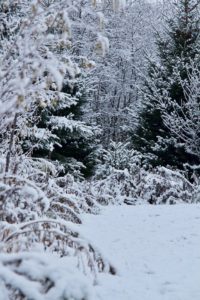By Jessica Johnsrud, Education Coordinator
Walking in my neighborhood was quite picturesque the morning after the recent snowstorm. Branches on the evergreen trees swooped low, heavy with snow and ice. Maple and birch trees stood tall and bare, encrusted with ice and snow along the bark and branches. They looked like sparkling skeletons against the soft blue sky.
 Trees are an important part of our landscape. There are two main types of trees: coniferous and deciduous. Deciduous trees have broad leaves that change color in autumn and shed before winter. Red maple, black cherry and white birch are a few examples of deciduous trees that grow at Woodland Dunes. Deciduous trees have thin leaves, and the water inside the leaf cells would freeze in the cold winter. Water expands when it freezes and would rupture the cells, causing damage. Deciduous trees drop their leaves in the fall as a winter survival strategy.
Trees are an important part of our landscape. There are two main types of trees: coniferous and deciduous. Deciduous trees have broad leaves that change color in autumn and shed before winter. Red maple, black cherry and white birch are a few examples of deciduous trees that grow at Woodland Dunes. Deciduous trees have thin leaves, and the water inside the leaf cells would freeze in the cold winter. Water expands when it freezes and would rupture the cells, causing damage. Deciduous trees drop their leaves in the fall as a winter survival strategy.
Coniferous trees, such as white pine and eastern hemlock, grow cones for reproduction and have needles or leathery, fern-like leaves. The needles have a waxy cuticle or coating that retains moisture and protects from freezing during the winter. Some produce an antifreeze that is concentrated in the cells to prevent freezing. Over the course of time, old needles drop and new needles grow. Most conifer trees are green year-round, however there are exceptions to every rule. The tamarack is a conifer tree, but every fall its needles turn golden yellow, then fall off.
Trees provide habitat for wildlife, but also offer extremely important ecosystem services. They clean the air, absorb rampant carbon dioxide, provide oxygen, prevent erosion, supply food and cool cities and streets. Interestingly, trees also heal. Research has shown that patients recover faster and with fewer complications if they have a view of trees from their window. Children with ADHD show reduced symptoms when they spend time in nature. Neighborhoods with trees have lower incidences of violence than neighborhoods that don’t have trees or have few trees. Doctors in the United States are even prescribing “park prescriptions” to their patients, encouraging them walk in a forest or park for a specific amount of time.
About 30% of Earth’s land area is forested and I am grateful to live in that 30%. Trees are an important part of our landscape and truly benefit everyone. They also make my walks in all four seasons, more interesting.
Photo taken at Woodland Dunes by Nancy Nabak
